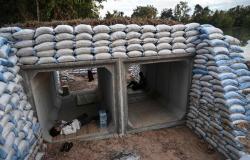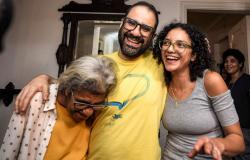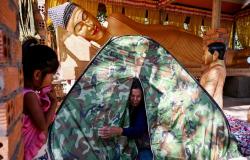Hello and welcome to the details of Amputations soar but prostheses and painkillers lacking in besieged Gaza and now with the details
Nevin Al Sukari - Sana'a - A boy drives a donkey-drawn cart carrying two children, jerrycans, sacks of flour, and other items while evacuating from the Tuffah neighbourhood in the east of Gaza City heading towards areas in the west, on June 24, 2024 amid the ongoing conflict in the Palestinian territory between Israel and Hamas. — AFP pic
GAZA, June 27 — There is little Gaza’s doctors can do to alleviate the pain that three-year-old Suhaib Khuzaiq still feels from a shrapnel injury that caused his leg to be amputated above the knee in December.
“He is in pain and in need of painkillers and a prosthetic limb that is only available outside Gaza”, his father Ali Khuzaiq, 31, told AFP from Gaza City’s Al-Ahli hospital where Suhaib receives treatment.
On December 6, an Israeli air strike on their neighbourhood of Tal Al-Hawa, southwest of Gaza City, injured Suhaib and destroyed their home, displacing the family who are now staying with relatives, Khuzaiq said.
The war and Israel’s blockade have caused a shortage of medicines and destroyed much of Gaza’s medical capacity.
Advertisement
As a result, amputations have become a key way of handling injuries that in other circumstances might have been treated differently, causing their number to soar further.
Citing data from UNICEF, the chief of the UN agency for Palestinian refugees said on Tuesday that in Gaza “every day 10 children... are losing one leg or two legs on average,” adding that it meant “around 2,000 children” had lost legs since the start of the war.
UNICEF’s spokesman Jonathan Crickx later told AFP that difficulties in gathering data in a war zone meant the figures were only “estimates” that would take time to verify, but that the agency “has met many children who have lost limbs”.
Advertisement
Mahmoud Basal, a spokesman for Gaza’s Civil Defence agency, told AFP that the estimate seemed realistic, because “as the civil defence crews work in the field, with every strike they recover children, many of whom lose either legs or arms, sometimes requiring amputations reaching high points on the limb”.
No prosthesis, no exit
Medical sources said that amputations are often the only available option, but they have to be performed in inadequate conditions.
“There are moments when anaesthesia is not available, but in order to save the lives of citizens, we resort to amputation, and this causes severe pain for the wounded”, doctor Maher, a surgeon at Al-Ahli hospital, told AFP.
“Every day, there are attacks that result in amputations of legs or arms for children, adults, and women.”
In May, nonprofit Save The Children said that “thousands of child amputees and injured children are struggling to recover without adequate pain relief and devices like wheelchairs”.
Proper prostheses are in short supply in the Gaza Strip, which is subject to a tight blockade that does not automatically allow medical equipment and medicines to enter the territory.
“God willing, the crossings will open and Suhaib will receive treatment outside Gaza. Hospitals here have neither treatment nor medicines”, Khuzaiq said.
The situation at his hospital is particularly dire because northern Gaza is harder to access, making shortages there graver while most hospitals are “going out of service due to direct targeting by the Israeli army”, he said.
Marwa Abu Zaida, 40, and her eight-year-old son Nasser Abu Drabi also hope to travel abroad to get access to treatment and prostheses.
Her leg and his arm were amputated after they were injured when an Israeli strike hit their home in the northern Gaza town of Beit Lahia.
“I hope that the war will end, that the crossing will be opened, and that facilities will be provided to us so that we can travel, install (artificial) limbs, and live our lives normally”, she told AFP from Al-Ahli hospital.
“My son and I worry when we need to change the wound dressing because of the pain we are experiencing”, she said, because they have no painkillers.
‘No hope’
Medical evacuations are needed but are rare in Gaza, including for other patients such as those in need of cancer treatment, said Bashar Murad of the Palestinian Red Crescent in Gaza.
“There is no cancer treatment in Gaza. We cannot treat cases with chemotherapy or radiation inside the Strip,” he said.
“The health sector has collapsed entirely in Gaza. 25,000 cases require travelling out of the Strip for treatment”, and only 4,000 have been able to leave”, Murad added.
Ali Khuzaiq has little hope that his son will be evacuated.
“People get sick and the healthy fall ill. There is no hope, comfort or anything uplifting”, he said.
The war started with Hamas’s October 7 attack on southern Israel, which resulted in the deaths of 1,195 people, mostly civilians, according to an AFP tally based on Israeli figures.
Israel’s retaliatory offensive has killed at least 37,765 people, also mostly civilians, according to data from the health ministry in Hamas-run Gaza. — AFP
These were the details of the news Amputations soar but prostheses and painkillers lacking in besieged Gaza for this day. We hope that we have succeeded by giving you the full details and information. To follow all our news, you can subscribe to the alerts system or to one of our different systems to provide you with all that is new.
It is also worth noting that the original news has been published and is available at Malay Mail and the editorial team at AlKhaleej Today has confirmed it and it has been modified, and it may have been completely transferred or quoted from it and you can read and follow this news from its main source.





